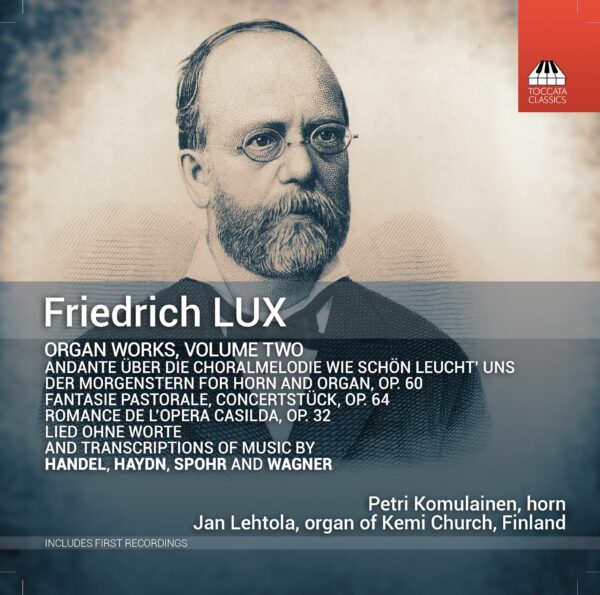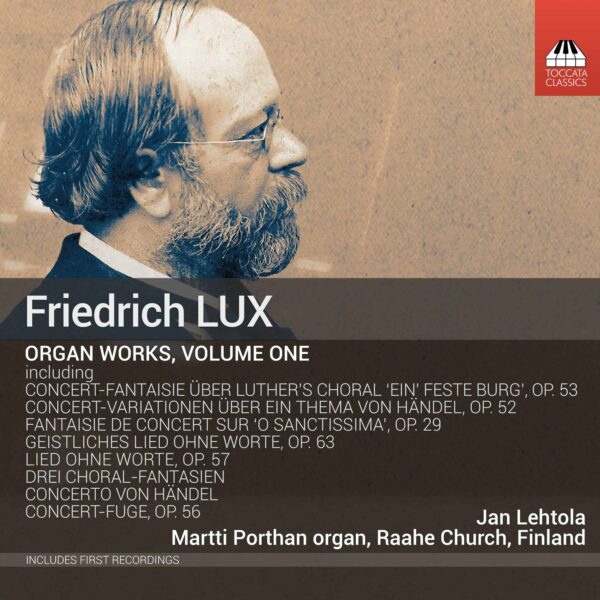Friedrich Lux: Organ Works, Volume Two
Friedrich Lux (1820–95) was one of those musicians who formed the fabric of musical life in nineteenth-century Germany: though he worked away from the major cities, as conductor, teacher, organist, organiser and composer, he was an indispensable element of the communities in which he worked. His large body of organ music, as good as unknown before now, brings together elements of the musical language of Bach, Mendelssohn and Schumann, in works that range from the intimate to the grandiose.This second volume brings some of his many transcriptions to the fore.
Petri Komulainen, horn
Jan Lehtola, organ of Kemi Church, Finland
Listen To This Recording:
Fantasie pastorale, Concertstück, Op. 64 (publ. 1881) (15:54)
- I. Allegro moderato (5:50)
- II. Andantino – Poco più mosso – Tempo I (5:07)
- III. Allegretto fugato (4:57)
- Lied ohne Worte (publ. 1877)* (4:46)
Variationen aus Kaiserquartett von Haydn (publ. 1879)* (11:27)
- Poco adagio (1:28)
- 1. Variation (1:38)
- 2. Variation (1:41)
- 3a. Variation (1:32)
- 3b. Variation (1:29)
- 4. Variation (3:39)
Drei Stücke aus Händel’s Messias in Form einer Sonate (publ. 1877) (11:55)
- No. 1 Chor: Ehre sei Gott (Allegro) (2:19)
- No. 2 Arie: Er weidet seine Heerde (Larghetto) (5:27)
- No. 3 Chor: Halleluja (Allegro moderato) (4:09)
- Andante über die Choralmelodie Wie schön leucht’ uns der Morgenstern, Op. 60 for horn and organ (publ. 1878)* (7:12)
- Adagio aus einem Nocturno von Louis Spohr (publ. 1878)* (5:52)
- Romance de l’opéra Casilda, Op. 32 (publ. 1863)* (6:28)
- Die Meistersinger von Nürnberg: Einleitung zum 3. Akt von Richard Wagner (publ. 1875)* (7:45)
- Marche célèbre de la 1ère Suite de F. Lachner, Op. 113 (publ. 1873)* (6:08)
*First Recordings


American Record Guide :
As with all of Lehtola’s productions […], the recorded sound, organs, and his committed playing are all first rate. The booklet contains extensive notes by the performer on the composer and music.’
—Robert Delcamp, American Record Guide, February 2024
American Organist :
‘I feel well rewarded for having delved into his seldom-heard music in this recording.
As to the organist, Jan Lehtola should need no introduction. This recording demonstrates again, if demonstration were needed, his effortless technique, elegant phrasing, and artistic handling of the instrument, both in touch and in registration. One couldn’t ask for a more sensitive interpreter. […]
The instrument is substantial, with three manuals, and while blessed with an abundance of mixtures and a clear, singing tone, it is also capable of Romantic warmth. […]
The music is original and enjoyable, ebullient and energetic.’
—Jonathan Hall, American Organist